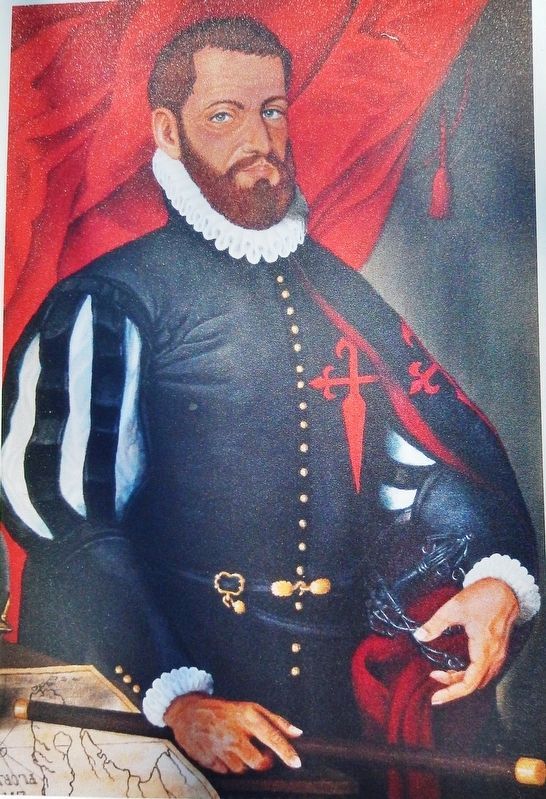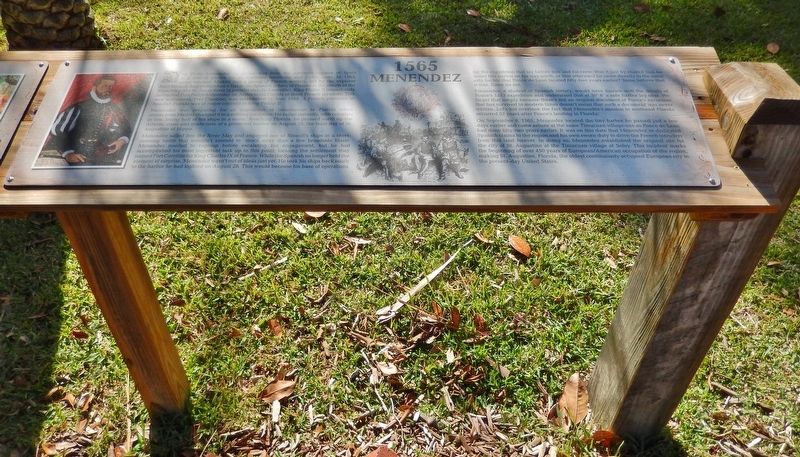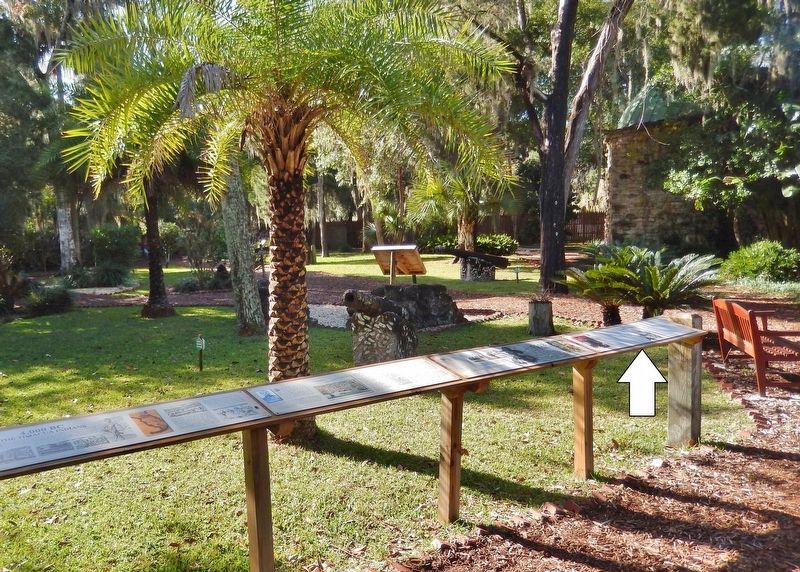Historic District in St. Augustine in St. Johns County, Florida — The American South (South Atlantic)
1565 Menendez
Don Pedro Menendez de Aviles was from the northern regions of Spain in a district known for its seafaring traditions and Celtic roots. In 1565, news reached Madrid that a group of French settlers, led by the explorer Jean Ribault, had established a fort in the Spanish colony of Florida at the mouth of the River May (the St. Johns River in present-day Jacksonville). King Phillip II immediately instructed Don Pedro Menendez de Aviles to rid Florida of these French invaders. This new settlement, Fort Caroline, was established in June 1564. A French presence in Spanish Florida was of major concern to King Phillip II.
Menendez was preparing for an expedition of colonization to Florida when orders from Madrid changed it to a military incursion. He sailed instantly, with colonists in tow, losing half of his ships in a storm. Reaching Florida, he pressed north up the Atlantic coast and made note of a protected harbor on August 28, the feast day of St. Augustine of Hippo.
Menendez sailed into the River May and engaged one of Ribault's ships in a short-running battle that wouldn't amount to much more than a few broadside blasts. Menendez needed to regroup before escalating the engagement, but he had accomplished his most important task up to this point: locating the settlement they named Fort Caroline for King Charles IX of France. While the Spanish no longer held the element of surprise, Menendez wasn't out of ideas just yet. He took his ships back south to the harbor he had sighted on August 28. This would become his base of operations for the expedition that lay before him and his crew. Was it just by chance that he noted this harbor on his way north, or that afterward he came directly to the same safe harbor that Ponce de Leon located fifty-two years earlier? Some believe that it was. Some do not.
Menendez, a student of Spanish history, would have known well the details of Ponce's 1513 expedition and understood that at 30° 8' a safe harbor lay near. We forget that simply because there's not an original document of Ponce's excursion that has survived to modern times doesn't mean that such a document was never written. Let's not overlook the fact that Menendez's mission to northeast Florida occurred 52 years after Ponce's landing in Florida.
On September 8, 1565, Menendez located the tiny harbor he passed just a few days earlier and came ashore at the same Timucuan village-site as Ponce de Leon had done fifty-two years earlier. It was on this date that Menendez re-dedicated Spanish claims to the region and his own sworn duty to drive the French intruders from this land forever. In doing so, Menendez established the original site for the city of St. Augustine at the Timucuan village of Seloy. This incident marks the beginning of over 450 years of European/American occupation of the region, making St Augustine, Florida, the oldest continuously occupied European city in the present-day United States.
Topics. This historical marker is listed in these topic lists: Colonial Era • Exploration • Settlements & Settlers • Waterways & Vessels. A significant historical year for this entry is 1565.
Location. 29° 54.404′ N, 81° 18.934′ W. Marker is in St. Augustine, Florida, in St. Johns County. It is in the Historic District. Marker can be reached from Williams Street east of Magnolia Avenue. Marker is located along the interpretive trail in Ponce de León's Fountain of Youth Archaeological Park. Touch for map. Marker is at or near this postal address: 11 Magnolia Avenue, Saint Augustine FL 32084, United States of America. Touch for directions.
Other nearby markers. At least 8 other markers are within walking distance of this marker. 1513 La Florida (here, next to this marker); Juan Ponce (here, next to this marker); Tabby / Coquina (here, next to this marker); 4,000 BC (here, next to this marker); Chief Saturiwa (a few steps from this marker); Tinajónes (a few steps from this marker); Ancient Civilization Uncovered! (a few steps from this marker); Spanish Cannon (a few steps from this marker). Touch for a list and map of all markers in St. Augustine.
Related markers. Click here for a list of markers that are related to this marker. Ponce de León's Fountain of Youth Archaeological Park
Also see . . . Pedro Menéndez de Avilés.
He is notable for planning the first regular trans-oceanic convoys, which became known as the Spanish treasure fleet, and for founding St. Augustine, Florida, in 1565. This was the first successful European settlement in La Florida and the most significant city in the region for nearly three centuries. St. Augustine is the oldest continuously inhabited, European-established settlement in the continental United States. Menéndez de Avilés was the first governor of La Florida (1565–74).(Submitted on December 25, 2021, by Cosmos Mariner of Cape Canaveral, Florida.)
Credits. This page was last revised on December 29, 2021. It was originally submitted on December 24, 2021, by Cosmos Mariner of Cape Canaveral, Florida. This page has been viewed 328 times since then and 24 times this year. Photos: 1, 2, 3, 4. submitted on December 25, 2021, by Cosmos Mariner of Cape Canaveral, Florida.



